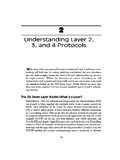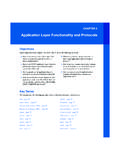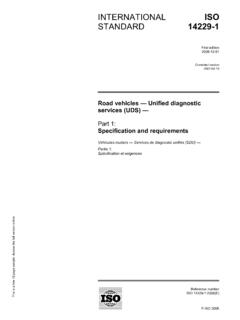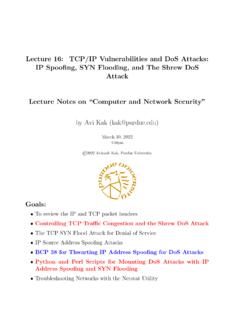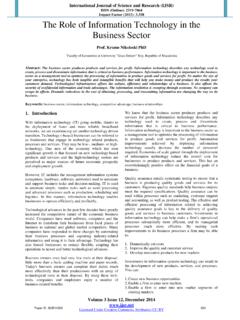Transcription of LoRa® and LoRaWAN®: A Technical Overview
1 LoRa and LoRaWAN: A Technical Overview Page 1 of 26 Technical Paper Proprietary February 11, 2020 Semtech LoRa and LoRaWAN : A Technical Overview Semtech Corporation December 2019 LoRa and LoRaWAN: A Technical Overview Page 2 of 26 Technical Paper Proprietary December 2019 Semtech What are LoRa and LoRaWAN ? LoRa is an RF modulation technology for low-power, wide area networks (LPWANs). The name, LoRa, is a reference to the extremely long-range data links that this technology enables. Created by Semtech to standardize LPWANs, LoRa provides for long-range communications: up to three miles (five kilometers) in urban areas, and up to 10 miles (15 kilometers) or more in rural areas (line of sight). A key characteristic of the LoRa-based solutions is ultra-low power requirements, which allows for the creation of battery-operated devices that can last for up to 10 years. Deployed in a star topology, a network based on the open LoRaWAN protocol is perfect for applications that require long-range or deep in-building communication among a large number of devices that have low power requirements and that collect small amounts of data.
2 Consider the differences between LoRa and other network technologies that are typically used in IoT or traditional machine-to-machine (M2M) connectivity solutions: Figure 1: IoT Technologies Note: In Europe, mobile network operators have implemented a dual strategy to address packet size and latency issues. They often offer both LoRaWAN and Cat-M1, which are complementary technologies. LoRaWAN accommodates the need for longer battery life, with a trade-off of longer latency and smaller packet sizes. In contrast Cat-M1 can be used for larger payloads with less latency than LoRaWAN can accommodate. LoRa and LoRaWAN: A Technical Overview Page 3 of 26 Technical Paper Proprietary December 2019 Semtech Figure 2 highlights some important advantages of deploying a LoRaWAN network: Figure 2: Advantages of deploying a LoRaWAN network Let s look into these advantages in a little more depth. With respect to range, a single LoRa-based gateway can receive and transmit signals over a distance of more than 10 miles (15 kilometers) in rural areas.
3 Even in dense urban environments, messages are able to travel up to three miles (five kilometers), depending on how deep indoors the end devices (end nodes) are located. As far as battery life goes, the energy required to transmit a data packet is quite minimal given that the data packets are very small and only transmitted a few times a day. Furthermore, when the end devices are asleep, the power consumption is measured in milliwatts (mW), allowing a device s battery to last for many, many years. LoRa and LoRaWAN: A Technical Overview Page 4 of 26 Technical Paper Proprietary December 2019 Semtech When it comes to capacity, a LoRaWAN network can support millions of messages. However, the number of messages supported in any given deployment depends upon the number of gateways that are installed. A single eight-channel gateway can support up to messages over the course of a 24-hour period. If each end device sends a message every hour, such a gateway can support up to 60,000 devices1.
4 If the network includes 10 such gateways, the network can support roughly 100,000 devices and one million messages. If more capacity is required, all that is needed is to add additional gateways to the network. And then, there is cost. Given the capabilities of LoRa-based end nodes and gateways, only a few gateways configured in a star network are required to serve a multitude of end nodes. This means that capital and operational expenses can be kept relatively low. Also, when the cost-effective LoRa RF modules that are embedded in inexpensive end nodes are used in conjunction with the open LoRaWAN standard, the return on investment can be considerable. Radio Modulation and LoRa A proprietary spread-spectrum modulation technique derived from existing Chirp Spread Spectrum (CSS) technology, LoRa offers a trade-off between sensitivity and data rate, while operating in a fixed-bandwidth channel of either 125 KHz or 500 KHz (for uplink channels), and 500 KHz (for downlink channels).
5 Additionally, LoRa uses orthogonal spreading factors. This allows the network to preserve the battery life of connected end nodes by making adaptive optimizations of an individual end node s power levels and data rates. For example, an end device located close to a gateway should transmit data at a low spreading factor, since very little link budget is needed. However, an end device located several miles from a gateway will need to transmit with a much higher spreading factor. This higher spreading factor provides increased processing gain, and higher reception sensitivity, although the data rate will, necessarily, be lower. LoRa is purely a physical (PHY), or bits layer implementation, as defined by the osi seven -layer Network model , depicted in Figure 3. Instead of cabling, the air is used as a medium for transporting LoRa radio waves from an RF transmitter in an IoT device to an RF receiver in a gateway, and vice versa. LoRa and LoRaWAN: A Technical Overview Page 5 of 26 Technical Paper Proprietary December 2019 Semtech Figure 3: osi seven -layer network model In a traditional or Direct Sequence Spread Spectrum (DSSS) system, the carrier phase of the transmitter signal changes according to a code sequence as shown in Figure 4.
6 When multiplying the data signal with a pre-defined bit pattern at a much higher rate, also known as a spreading code (or chip sequence), a faster signal is created that has higher frequency components than the original data signal. This means that the signal bandwidth is spread beyond the bandwidth of the original signal. In RF terminology, the bits of the code sequence are called chips (in order to distinguish between the longer, un-coded, bits of the original data signal). When the transmitted signal arrives at the RF receiver, it is multiplied with an identical copy of the spreading code used in the RF transmitter, resulting in a replica of the original data signal. LoRa and LoRaWAN: A Technical Overview Page 6 of 26 Technical Paper Proprietary December 2019 Semtech Figure 4: DSSS system carrier phase transmitter signal changes You might ask: Why go through all this trouble? Why not just transmit the original data signal instead of going through this code sequence multiplication?
7 The answer is simple: going through this code sequence multiplication buys you a higher RF link budget, so you can transmit over a longer range. The Log10 ratio of the code sequence s chip rate and the data signal s bit rate is called the processing gain (Gp). This gain is what allows the receiver to recover the original data signal, even if the channel has a negative signal-to-noise ratio (SNR). LoRa has a superior Gp compared to frequency-shift keying (FSK) modulation, allowing for a reduced transmitter output power level while maintaining the same signal data rate and a similar link budget. One of the downsides of a DSSS system is the fact that it requires a highly-accurate (and expensive) reference clock. Semtech s LoRa Chirp Spread Spectrum (CSS) technology offers a low-cost and low- LoRa and LoRaWAN: A Technical Overview Page 7 of 26 Technical Paper Proprietary December 2019 Semtech power, yet robust, DSSS alternative that does not require a highly-accurate reference clock.
8 In LoRa modulation, the spreading of the signal s spectrum is achieved by generating a chirp signal that continuously varies in frequency, as is depicted in Figure 5. An advantage of this method is that the timing and frequency offsets between transmitter and receiver are equivalent, greatly reducing the complexity of the receiver design. The frequency bandwidth of this chirp is equivalent to the spectral bandwidth of the signal. The data signal that carries the data from an end device to a gateway is chipped at a higher data rate and modulated onto the chirp carrier signal. LoRa modulation also includes a variable error correction scheme that improves the robustness of the transmitted signal. For every four bits of information sent, a fifth bit of parity information is sent. Key LoRa Modulation Properties As noted above, LoRa processing gain is introduced in the RF channel by multiplying the data signal with a spreading code or chip sequence. By increasing the chip rate, we increase the frequency components of the total signal spectrum.
9 In other words, the energy of the total signal is now spread over a wider range of frequencies, allowing the receiver to discern a signal with a lower (that is, worse) signal-to-noise ratio (SNR). In LoRa terms, the amount of spreading code applied to the original data signal is called the spreading factor (SF). LoRa modulation has a total of six spreading factors (SF7 to SF12). The larger the spreading factor used, the farther the signal will be able to travel and still be received without errors by the RF receiver. Table 1 shows the four different spreading factors [ ] that can be used for uplink (UL) messages on a 125 KHz channel1. It shows the equivalent bit rate as well as the estimated range (this depends on the terrain; longer distances will be achieved in a rural environment thank in an urban environment). It also shows the dwell time, or time on air (TOA), values for an 11-byte payload for each of the four spreading factors. 1 Downlink messages broadcast over 500 KHz channels can use all six available spreading factors ( ).
10 Figure 5: LoRa Chirp Spread Spectrum illustration LoRa and LoRaWAN: A Technical Overview Page 8 of 26 Technical Paper Proprietary December 2019 Semtech Table 1: LoRa Spreading Factors Importantly, the LoRa modulation spreading factors are inherently orthogonal. This means that signals modulated with different spreading factors and transmitted on the same frequency channel at the same time do not interfere with each other. Instead, signals at different spreading factors simply appear to be noise to each other. LoRa signals are robust and very resistant to both in-band and out-of-band interference mechanisms. LoRa modulation also offers immunity to multipath and fading, making it ideal for use in urban and suburban environments, where both mechanisms dominate. Additionally, Doppler shifts cause a small frequency shift in the time axis of the baseband signal. This frequency offset tolerance mitigates the requirement for tight tolerance reference clock sources and, therefore, makes LoRa ideal for data communications from devices that are mobile.
